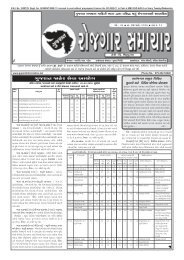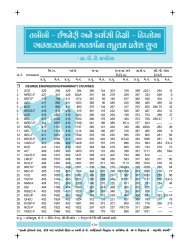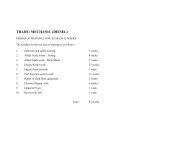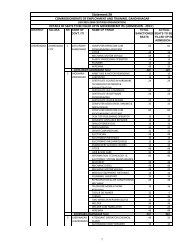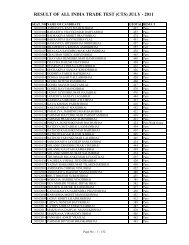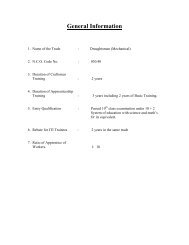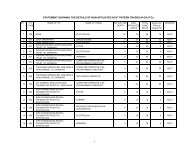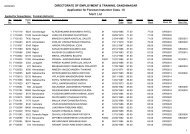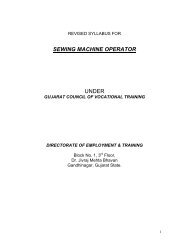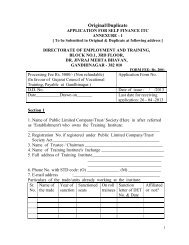View - Talim Rojgar
View - Talim Rojgar
View - Talim Rojgar
You also want an ePaper? Increase the reach of your titles
YUMPU automatically turns print PDFs into web optimized ePapers that Google loves.
GOVERNMENT OF GUJARAT<br />
DIRECTOR OF TECHNICAL EDUCATION<br />
CRAFTSMEN TRAINING SCHEME<br />
Course : General Mechanic<br />
(Fitting Turning Welding and Blacksmith)<br />
Admission Qualification : 7 th Standard Pass,<br />
Period of Training : 2 Year<br />
Working Hours, 45 Hours per Week<br />
Teachingschemeperiod-1hreach<br />
----------------------------------------------------------------------------------------------------------<br />
Subject Lecture/Week : Practical/Week<br />
----------------------------------------------------------------------------------------------------------<br />
Trade Theory 7 -<br />
Practical - 30<br />
Workshop Calculation 4 -<br />
Engineering Drawing 4 -<br />
----------------------------------------------------------------------------------------------------------<br />
Examination Scheme :<br />
(1) Workshop calculation - 3 hours, 100 marks, one paper<br />
(2) Engineering drawing - certified subject.<br />
(3) Trade theory - 3 hours, 100 marks, one paper.<br />
(4) Trade practice. - 6 to 8 hours practical in each<br />
Trade, 200 marks of each practical in each trade,<br />
Practical total marks: 1000 marks<br />
Minimum marks required for passing -50% in workshop calculation<br />
And trade theory and 60% in trade practical.<br />
Syllabus for:<br />
(1) Workshop calculation.<br />
Simple problems involving addition, subtraction,<br />
Multiplication,division and common fraction,<br />
Decimal-addition,division,conversion of cecimal<br />
To common fraction and vice-a-versa.<br />
Mensuration-areas of rectangle, square,triangle,<br />
Circle etc. Volume of simple solid bodies such as<br />
Cube, cylinder, pyramid and one.<br />
1
(2) Engineering drawing :-<br />
Simple geometrical constructions-drawing parallels,<br />
Ereacting perpendicular, constructing angle, triangle,<br />
Quadrilateral, circle and polygon Division of lines<br />
And angles, locating centre of areas etc.<br />
Printing of letters and figures, conventional sizes, sections<br />
Materials or theographic projection, sketching and drawing of<br />
Plan, elevation, and views of solid a and simple machine parts<br />
Such as bolts, nuts, rivets bearing etc. reading of blue prints.<br />
(3) Trade theory.<br />
(i) Fitting:<br />
Description and application of simple measuring tools such as steel rules, calipere<br />
vernise, micrometer etc<br />
Description of vices, types of hammers, cold chisels, files, screw driver, hacksews etc.<br />
And proper method of using them. Method of marking objects with the help of marking<br />
table, dividers, scribing blocks, vee block, centre punch, odd leg callipers etc. Methods<br />
of using drills, taps, dies, etc.descripition of standard screw threads and froms. Methods<br />
of using surface plates . Description of different types of scrappers. Different types of<br />
locking and fastening devices.e.g nutsboltsrivetsetc,andtheir uses in making jointes.<br />
Method of soldering and brazing,ferrous and non ferrous metals. Trade practice:-use of<br />
fitters hand tools, dhipping filling hacksawing, marking off. Filing true and square,<br />
filling angular and curved surfaces. Drilling-hand and machine, use of taps and dies,<br />
simpel fitting. Grinding of chiesels, use ofspanners, pliers, screw drivers, etc. Making<br />
and fitting of studs, rivetting.<br />
(ii) Turning ;-<br />
Drill, tapes, dies, and reamers – their types, maintenance and use Precision<br />
measuring instrument and guage micrometer, vernier, callipers, heights guage depth<br />
gauges plug and ring guage, limit guages, screw and pitch guages center guage feeler<br />
guages etc. Spirit level .Leth ;- classification and types, size of lethe important<br />
assemblies and parts such as head stock tail stock , live and dead cen centres lead screw,<br />
bed compound rest etc. And their functions.<br />
Lathe – accessories –chuck, face plate, steady and sliding rests job carrier, boring bar<br />
gear train. Taper turning attachments, milling attachments, tool post grinder, etc .angle<br />
plate and its function and use. Lathe tools forged and tipped. Type of lathe tools their<br />
names , description, tool materials use,care and maintenance of tools tool aggles –top<br />
rank, cutting angle, clearance angles, profile angleetc. And their importance . Tampering<br />
of tool. Granning of tools. Tools holde ers and tool posts . Plain and taper turning taper<br />
turning attachements cutteing speed and feed ,coolants.<br />
2
Common screw threads-b.s.w. b.s.f. b.s.p squar, acme, buttress, seller etc.details of all<br />
standard threads. Single and multi start threads. Pitch and lead<br />
Determination of gear train for screw cutting. Metric thread calculation. Worm screw<br />
cutting. Knurling tools-their description, us care and maintenance. Eccentric and crank<br />
shaft turning-determination of centre displacement. Method of turning split bearings<br />
methods of setting up irregular shaped articles on face plate/and angle plates for turning.<br />
(iii) Welding:<br />
(a) Gas Welding:<br />
precautions in gas and electric welding, elementry knowledge of first aid.<br />
Descriotion and use of tools and equipment used in gas weldig welding terms and<br />
definitions different processes of motal joining, bolting, rivetting, soldering, brazing etc.<br />
Common gases used in welding-oxygen, hydrogen and acetylene ete. Common gases<br />
used in welding-oxygen, and acetylene etc. Types of joint care and maintenance oxyacetylene<br />
cylinder welding, blow pipes, types description operation, care and<br />
maintenance, faults in gas welding bronze, copper, alluminimum welding and fluxes<br />
used. Principales of gas cutting wih blowpipe. Simple estimation.<br />
Practice: simple exercises in gas welding lap joing, butt point, edge joint, open corner<br />
joint, square but joint, teem point, pipe welding, brass, copper, aluminium and cast iron<br />
welding.<br />
Arc welding: description and use of tolls used in welding. Welding terms and definitions<br />
(advantages and advantages) electrodes-types-object of coatingcnaractristic of flur<br />
polirity methods of ineitification mportao on mprotannce and indicationd of wrong<br />
polarityrc blow ets defects –methods to ovecome in practice.<br />
Rugolator –types –construction use care and maintenance<br />
Tipe welding by arcand gas methods advantages<br />
Practice : simple axercises in arc welding. Lap joint square butt joint.<br />
Edge joint, pipe welding ,bronsc, alluminum ,stinless steck and cast iron welding .<br />
(b) Block smithy:<br />
The forge, different types, construction operation and maintenance. The brick hearth.<br />
Arrangements of air supply, hand belows and blower. Fuels used. Lighting and<br />
management of fire. Importance of maintraing cleane fire. Regulation of the size of fire<br />
for specific purposes. Smiths common tools and equipment, anivil, swage block, leg<br />
vive hammers tongs chisels (hot and cold) fullers, flatters, punches, drifts brass rules,<br />
square, callipers, dividers etc. Their descriotion, materials from which made and sue.<br />
Care and maintenance of tools and equipments cuages and templates and their use.<br />
Simithy operations, forging, welding and finishing heats for ging temperature heating<br />
defects under heating and over heating forging of high speed and alloy steels welds.<br />
Types of welds. Principle of braing bending of plates. Angle iron, pipes etc. Shrink<br />
fitting of rings on care wheels ect.<br />
3
(4) Practices:<br />
Lighting and management of fire. Regulating size of fire for given jobs, heating the jobs<br />
cutting, up setting, drawing and bending of atticles to given dimensions, punching and<br />
drilling, rivetting and caulking and fullering. Welds-lap, buttm scart tee etc.<br />
Making of tools and appliances.<br />
Making of agricultural implements, such as axes, pick axe showl etc.<br />
Bending bar flat, angle,tee, and channel irons and pipes to given angles and radi1.<br />
Shrink fiting of rings on bars, and brushes to given dimensions.,<br />
Fitting of iron tyres to cart wheels.<br />
4



